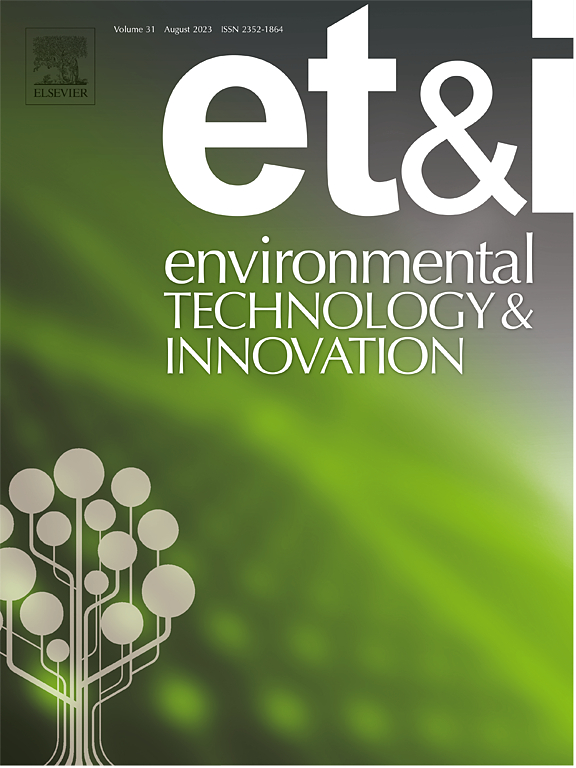Synergistic impacts of anthropogenic and climatic drivers on total phosphorus dynamics in a mega river basin
IF 6.7
2区 环境科学与生态学
Q1 BIOTECHNOLOGY & APPLIED MICROBIOLOGY
引用次数: 0
Abstract
Total phosphorus (TP) pollution in the Yangtze River basin (YRB) severely threatens ecosystems. Previous studies have examined individual factors affecting TP, but the combined impacts of anthropogenic activities and climate factor remain unclear. This study analyzed TP data from 636 sites in the YRB during 2016–2020 using partial least squares structural equation modeling to assess these combined effects on TP pollution. Results showed government regulation significantly reduced TP concentration from 2016 to 2020. Anthropogenic activities, including changes in landscape, GDP, and population growth, significantly influenced TP concentrations. Cropland and impervious surfaces were major TP sources, while forests acted as effective TP sinks. Landscape fragmentation weakened the ability of source landscapes to export TP to water bodies and the purification capacity of sink landscapes, while aggregation enhanced sink capacity. GDP and population growth were positively correlated with TP, but their impacts were partially mitigated by landscape adjustments and policy interventions. Climate factor also significantly affected TP concentrations. Precipitation influenced surface runoff and pollutant generation, playing a key role in non-point source pollution and amplifying the positive impact of landscape sources on TP. Air temperature promoted the release of internal phosphorus by affecting water temperature, water body stratification, and dissolved oxygen concentrations. Wind speed could weaken the release of TP from landscape sources to water bodies. Future efforts should focus on optimizing landscape patterns, enhancing sink landscape aggregation, and strengthening environmental governance, while considering climate impacts in water quality management to ensure the sustainable development of the YRB.
特大流域人为和气候驱动因素对总磷动态的协同影响
长江流域总磷污染严重威胁着生态系统。以往的研究考察了影响总磷的个别因素,但人类活动和气候因素的综合影响尚不清楚。本研究利用偏最小二乘结构方程模型分析了2016-2020年长江三角洲636个站点的总磷数据,以评估这些因素对总磷污染的综合影响。结果显示,2016年至2020年,政府监管显著降低了总磷浓度。人类活动,包括景观、GDP和人口增长的变化,显著影响TP浓度。农田和不透水地表是总磷的主要来源,而森林是有效的总磷汇。景观破碎化削弱了源景观向水体输出TP的能力和汇景观的净化能力,集聚化增强了汇能力。GDP和人口增长与TP呈正相关,但其影响被景观调整和政策干预部分缓解。气候因子对总磷浓度也有显著影响。降水影响地表径流和污染物生成,在非点源污染中发挥关键作用,并放大景观源对总磷的积极影响。气温通过影响水温、水体分层和溶解氧浓度促进体内磷的释放。风速可以减弱景观源向水体的总磷释放。未来应从优化景观格局、增强汇景观集聚、加强环境治理等方面着手,同时在水质管理中考虑气候影响,确保长江三角洲的可持续发展。
本文章由计算机程序翻译,如有差异,请以英文原文为准。
求助全文
约1分钟内获得全文
求助全文
来源期刊

Environmental Technology & Innovation
Environmental Science-General Environmental Science
CiteScore
14.00
自引率
4.20%
发文量
435
审稿时长
74 days
期刊介绍:
Environmental Technology & Innovation adopts a challenge-oriented approach to solutions by integrating natural sciences to promote a sustainable future. The journal aims to foster the creation and development of innovative products, technologies, and ideas that enhance the environment, with impacts across soil, air, water, and food in rural and urban areas.
As a platform for disseminating scientific evidence for environmental protection and sustainable development, the journal emphasizes fundamental science, methodologies, tools, techniques, and policy considerations. It emphasizes the importance of science and technology in environmental benefits, including smarter, cleaner technologies for environmental protection, more efficient resource processing methods, and the evidence supporting their effectiveness.
 求助内容:
求助内容: 应助结果提醒方式:
应助结果提醒方式:


